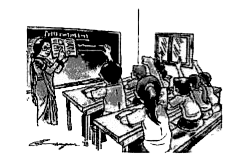For teaching the concept of probability, Mrs. Verma decided to use two dice. Shet took a pair of die and write all the possible outcomes on the blackboard. All possible outcomes wave:

(1,1), (1,2), (1,3), (1,4), (1,5), (1,6)
(2,1), (2,2), (2,3), (2,4), (2,5), (2,6)
(3,1), (3,2), (3,3), (3,4), (3,5), (3,6)
(4,1), (4,2), (4,3), (4,4), (4,5), (4,6)
(5,1), (5,2), (5,3), (5,4), (5,5), (5,6)
(6,1), (6,2), (6,3), (6,4), (6,5), (6,6)
The probability that 5 will come up at least once is:
1318
0
1136
518
Step by step video & image solution for For teaching the concept of probability, Mrs. Verma decided to use two dice. Shet took a pair of die and write all the possible outcomes on the blackboard. All possible outcomes wave: (1,1), (1,2), (1,3), (1,4), (1,5), (1,6) (2,1), (2,2), (2,3), (2,4), (2,5), (2,6) (3,1), (3,2), (3,3), (3,4), (3,5), (3,6) (4,1), (4,2), (4,3), (4,4), (4,5), (4,6) (5,1), (5,2), (5,3), (5,4), (5,5), (5,6) (6,1), (6,2), (6,3), (6,4), (6,5), (6,6) The probability that 5 will come up at least once is: by Maths experts to help you in doubts & scoring excellent marks in Class 10 exams.
Updated on:21/07/2023Topper's Solved these Questions
- SAMPLE PAPER 9 (SELF-ASSESSMENT)BOOK - EDUCART PUBLICATIONCHAPTER - SAMPLE PAPER 9 (SELF-ASSESSMENT)EXERCISE - Section -B
20 Videos
- SAMPLE PAPER 9BOOK - EDUCART PUBLICATIONCHAPTER - SAMPLE PAPER 9EXERCISE - SECTION C
10 Videos
- SAMPLE PAPER SELF ASSESSMENT 11BOOK - EDUCART PUBLICATIONCHAPTER - SAMPLE PAPER SELF ASSESSMENT 11EXERCISE - Section (iv)
13 Videos
Similar Questions
For teaching the concept of probability, Mrs. Verma decided to use two dice. Shet took a pair of die and write all the possible outcomes on the blackboard. All possible outcomes wave:

(1,1), (1,2), (1,3), (1,4), (1,5), (1,6)
(2,1), (2,2), (2,3), (2,4), (2,5), (2,6)
(3,1), (3,2), (3,3), (3,4), (3,5), (3,6)
(4,1), (4,2), (4,3), (4,4), (4,5), (4,6)
(5,1), (5,2), (5,3), (5,4), (5,5), (5,6)
(6,1), (6,2), (6,3), (6,4), (6,5), (6,6)
The probability that 6 will come up on both dice is
View SolutionFor teaching the concept of probability, Mrs. Verma decided to use two dice. Shet took a pair of die and write all the possible outcomes on the blackboard. All possible outcomes wave:

(1,1), (1,2), (1,3), (1,4), (1,5), (1,6)
(2,1), (2,2), (2,3), (2,4), (2,5), (2,6)
(3,1), (3,2), (3,3), (3,4), (3,5), (3,6)
(4,1), (4,2), (4,3), (4,4), (4,5), (4,6)
(5,1), (5,2), (5,3), (5,4), (5,5), (5,6)
(6,1), (6,2), (6,3), (6,4), (6,5), (6,6)
The probability that 4 will not come up on either of them is
View Solution
Knowledge Check
There are three relations R1,R2 and R3 such that
R1={(2,1),(3,1),(4,2)},
R2 = {(2,2),(2,4),(3,3),(4,4)} and
R3 = {(1,2),(2,3),(3,4),(4,5),(5,6),(6,7)}
thenAR1andR2 are functionsBR2andR3 are functionsCR1andR3 are functionsDOnly R1 is a function556+[223−[334(345÷912)]]
A7B223C447D436
For teaching the concept of probability, Mrs. Verma decided to use two dice. Shet took a pair of die and write all the possible outcomes on the blackboard. All possible outcomes wave:

(1,1), (1,2), (1,3), (1,4), (1,5), (1,6)
(2,1), (2,2), (2,3), (2,4), (2,5), (2,6)
(3,1), (3,2), (3,3), (3,4), (3,5), (3,6)
(4,1), (4,2), (4,3), (4,4), (4,5), (4,6)
(5,1), (5,2), (5,3), (5,4), (5,5), (5,6)
(6,1), (6,2), (6,3), (6,4), (6,5), (6,6)
The probability that both numbers comes up are even, is
View SolutionFor teaching the concept of probability, Mrs. Verma decided to use two dice. Shet took a pair of die and write all the possible outcomes on the blackboard. All possible outcomes wave:

(1,1), (1,2), (1,3), (1,4), (1,5), (1,6)
(2,1), (2,2), (2,3), (2,4), (2,5), (2,6)
(3,1), (3,2), (3,3), (3,4), (3,5), (3,6)
(4,1), (4,2), (4,3), (4,4), (4,5), (4,6)
(5,1), (5,2), (5,3), (5,4), (5,5), (5,6)
(6,1), (6,2), (6,3), (6,4), (6,5), (6,6)
The probabiliyt that both numbers comes up are prime numbers, is
View SolutionIf A={1,2,3},B={3,4}andC={4,5,6},then prove that(A×B)∪(A×C) ={(1,3),(1,4),(1,5),(1,6),(2,3),(2,4),(2,5),(2,6),(3,3),(3,4),(3,5),(3,6)}
View SolutionWhich of the following relations are functions? Give reasons. If it is a function, determine its domain and range:
(i) {(2,1), (3,1),(4,2)}
(ii) {(2,2),(2,4),(3,3),(4,4)}
(iii) {(2,1),(5,1),(8,1),(11,2),(14,2),(17,2)}
(iv) {(1,2),(2,3),(3,4),(4,5),(5,6),(6,7)}
(v){(2,1),(4,2),(6,3),(8,4),(10,5)}
(vi) {(1,2),(2,3),(3,4),(3,5),(3,7),(4,8)}
View SolutionUsing integration, find the area of the region bounded by :
(i)(1,0),(4,5)and(6,3)
(ii) (1,0),(2,2)and(3,1)
(iii)(−1,2),(1,5)and(3,4)
(iv) (2,3),(3,5)and(3,4)
(v) (−1,0),(1,3)and(3,2)
(vi) (1,3),(2,5)and(3,4)
(vii) (4,1),(6,6)and(8,4)
(viii) (2,5),(4,7)and(6,2)
(ix) (−2,1),(0,4)and(2,3)
(x) (2,1),(3,4)and(5,2).
View SolutionIn the following which is a function ? (i) {(1,2),(2,3),(3,4),(4,5),(5,6),(6,7)}
View Solution
